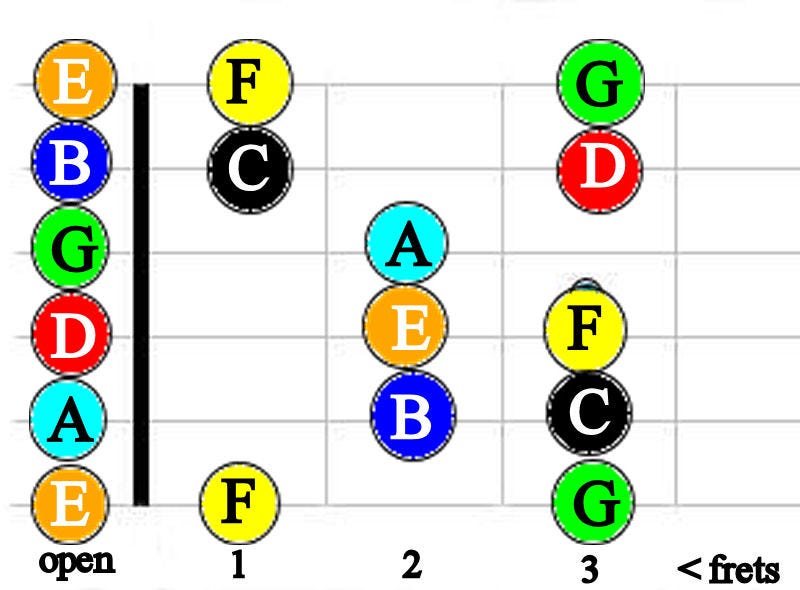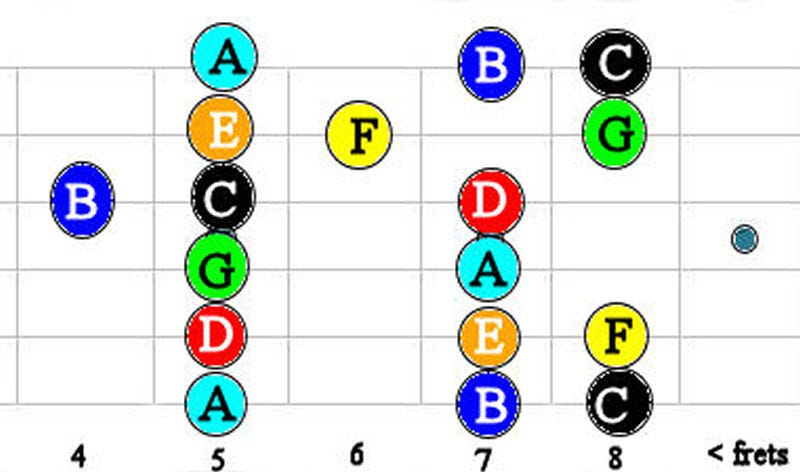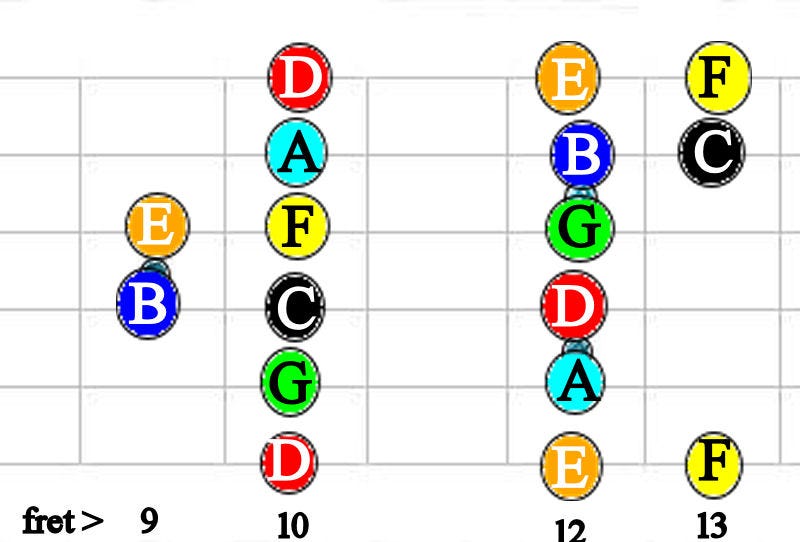Why is it important to know the location and names of all of the notes on the guitar fret board? In a word, "Structure". You need to know structure in order to understand basic music theory. Think of the fret board as “the alphabet”. In order to know how to spell words, we need to know the letters, their names and what they sound like. Think of all of the notes on the fret board as having individual colors. These colors are what you use to paint sound on the canvas of your guitar.
Six strings.
All six strings on your guitar have various thicknesses. The sixth string (low E) is the thickest string. It is thicker because it must be able to resonate the lowest "bass" notes on the guitar.
The first string (high E) is the thinnest string. It is thinner because it must be able to resonate the highest notes on the guitar. So much of this also has to do with the design of the guitar. If you look at a bass guitar, the strings are considerably thicker, and the neck of the bass guitar is also significantly longer. This is because the notes played on the bass guitar are one octave lower than the notes on the standard six string guitar.
Why are there six strings on the guitar, and why do each of them have different thicknesses?
Think of each of the strings on the guitar as six separate linear sets of notes that all overlap each other, string to string, at certain points chromatically. This is important to know because the guitar is considered a "relative" instrument. All of the notes are relative to each other by design. The same note can be played in multiple places on the guitar, opposed to the piano or a melody instruments like brass or woodwind, one note can only be played in one place.
For example, on the guitar, if you play the "C" on the 20th fret of the sixth string, that same note can be played on the 15th fret of the fifth string, the 10th fret of the fourth string, the 5th fret of the third string, and the 1st fret of the second string. That same on the piano can only be played in one place.
The Relative concept.
The chords you know come from the “relative concept” structure. Meaning: You can play the same chord in multiple places throughout the entire fret board, in various combinations called "inversions", and in different octaves. This is why there are so many ways to play the same chord on the guitar. Now - knowing this, we need to know all of the notes on the fret board, in order to better understand the structures of all of the chord we know and learn in our vocabulary.
Chord structures and application.
Every chord on the guitar requires a structure. For example, a basic major triad chord requires three notes: The root, its 3rd and 5th (I - III - V). This means that you can find each of these notes throughout the entire fret board. It is usually better from a rhythm perspective, to try to keep the root note as the lowest note of the structure, but this is not an absolute requirement. I personally think that it just sounds better to have a roots on the bottom...you know, like a tree.
Fret board Positioning.
Most guitarists will agree that there are "three positions" on the fret board. The first position is roughly placed between the open strings and the 4th fret. The second position is roughly placed between the 4th and 8th frets, and the third position is roughly placed between the 8th and 12th frets. Most of this depends on which key you are in.
Learning the notes in each position.
There are a couple of ways that you can learn the notes on the fret board. They include memorization of notes in scales, or simply learning the names of all of the notes in all of the chords that you know. Both ways work well.
You can also simply test yourself by memorizing where all of the notes exist throughout the fret board. Keep in mind, unless you have either a photographic memory or an eidetic memory, you're probably going to have to practice this stuff for many hours; and commit yourself to studying on a daily basis. There's simply no other way around it.
Easiest way to start.
The key of C major is all seven natural note: C, D, E, F, G, A and B. I think that this is the easiest place to start to learn the entire fret board in under a week, provided you actually put the time in to memorize it. (Note: Sharped and Flatted notes exist in the empty spaces between the natural notes).
You can see in this diagram all of the notes in the key of C major in the first position:
Here is the second position:
And the third position:
To practice this exercise, play each note in order of the "circle of fifths": F, C, G, D, A, E, B. I do not recommend that you do this exercise in a linear approach as it defeats the purpose of the relative understanding of the fret board. Linear understanding of notes on each string will happen by default by learning them in a relative approach. Practice the first position until you know where all of the natural notes are in under two seconds. Once you have it, you can move on to the second and third positions. If you must count to get to a note, do not use your fingers! Use your eyeballs. Counting frets with your fingers is not an option, ever!
The second way to learn notes using chords.
We will use the chords in the key of C major for this exercise: C, Dm, Em, F, G, Am and B°. Once you have the notes memorized for each of those seven chords, you can add their "7's": CM7, Dm7, Em7, FM7, G7, Am7 and B°7. Learn and memorize all of the notes played in every chord in the first position before you move on to the other two positions. You can find all of the chords you will need here.
Using scales.
It is very important to learn the following scales: Major (Ionian), minor (Aeolian), major and minor pentatonic scales. If you'd like to learn more about modal scales, names and their importance, go to my Guitar Lessons tab or use the search icon and type in "scales", "modes" or anything that you might be interested in reviewing.
Learning the C major and A minor scales are both really the same thing. They have the exact same notes. The only real difference is C is the root note for the major scale and A is the root note for the minor scale. The pentatonic scales are used often in pop, rock, blues and country music. Most beginners learn the minor pentatonic scale first. The idea is to learn the names of the notes in every scale/mode you play so that you will better understand the entire fret board. Learning all of the notes is like learning a new language; a language that is spoken universally by all musicians.








